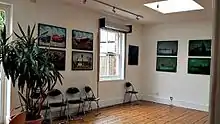| Butetown History and Arts Centre | |
|---|---|
 Logo of the Butetown History and Arts Centre | |
| General information | |
| Town or city | Cardiff |
| Country | Wales, United Kingdom |
| Coordinates | 51°27′57″N 3°09′55″W / 51.46596562443073°N 3.165202086807714°W |
| Opened | 1988 |
| Closed | December 2017 |
Butetown History & Arts Centre (BHAC) was a historical archive, educational centre and art gallery located in the Butetown area of Cardiff, Wales. BHAC was founded by Glenn Jordan as a non-profiting organisation with the aim to involve the local people of Butetown to help promote the area's history of the docklands.
Background
%252C_Bute_Street%252C_June_2020.jpg.webp)
BHAC was located in the heart of Butetown (previously known as Tiger Bay), one of the UK's oldest multi-racial communities.[1] The community centre started off as a place for weekly oral history classes and was the initiative of African-American academic, Glenn Jordan, who arrived in Cardiff during the 1980s and decided to stay, hoping to allow the Tiger Bay residents a chance to track the 150-year history of Cardiff Bay.[1] Jordan and BHAC have aimed to create an archive of local people's memories, documents and photographs.[1] The Centre emerged in 1988 with the help of a small handful of local residents, meeting at the Butetown Community Centre where they learnt interview techniques and recording methods.[2] By 2000 the centre had recorded several hundred hours of oral history, published several books and was running cultural-political and educational activities for local adults. By 2005 the centre had collected 450 hours of oral history and 3,000 photographs.[3] BHAC's collection also includes paintings, photographs and sculptures by local artists. It occupied a 2,500 square feet (230 m2) building in the centre of Butetown,[2] which it moved into in 1996 with the help of European funding.[1]
The centre was featured in a 2001 report, "Creative Regeneration: Lessons from 10 Community Arts Projects", by the Joseph Rowntree Foundation.[1]
Visual and performing arts was an important part of BHAC's work. The centre now runs the Diversity Arts Wales (DAW) programme – an initiative, funded by the Arts Council of Wales, that supports the professional development of artists from ethnic minority backgrounds. DAW also encourages artists, whatever their background, to engage in multicultural and intercultural work.
BHAC was funded by the Home Office, Welsh Assembly, Arts Council for Wales, Cardiff Council and various foundations.[4] However the BHAC now relies largely on volunteer staff and income from the museum shop.
Archive
One of the main areas within the BHAC is the archive which is the result of over 25 years of collecting history connected to the multicultural area of Cardiff Bay. By 2005 BHAC had collected 3000 photographs and 500 hours of oral history.[5] The centre's collection also includes paintings, videos, official documentation and sculptures by local artists. The priority of the BHAC was to make the archive fully accessible online and to add to the collection, to expand their multimedia displays and educational materials to allow for more exhibitions.[5]
Visual and performing arts

Since 2003, BHAC held nineteen exhibitions, which focused on bringing awareness of Wales as a culturally and ethnically diverse nation.[6] Some of the pieces were featured on BBC’s ‘Your Paintings’.[7]
Publishing
Within the Butetown History and Arts Centre, there have been a number of books published over the years. All of the books held in the BHAC are based around Cardiff Bay and they all, in one way or another, focus upon the Bay's history such as; 'Butetown & Cardiff Docks' compiled by Brian Lee and Butetown History & Arts Centre.[8]
Closure
In May 2016 the centre's committee announced they had no alternative but to close BHAC, because of a lack of new funding. They were looking for a storage facility to preserve their archive.[9] The centre is reported as closed in December 2017.
Much of their archive material has been transferred to The Heritage & Cultural Exchange.
References
- 1 2 3 4 5 Alistair Benjamin (14 March 2001). "Mixed metaphor: Alison Benjamin on why it took an American academic to trace Tiger Bay's history of proving that racial harmony isn't just a dream". The Guardian. Retrieved 2 May 2014.
- 1 2 Gilroy, Paul; Grossberg, Lawrence; McRobbie, Angela (2000), Without Guarantees: In Honour of Stuart Hall, London: Verso, pp. 167–176, ISBN 1-85984-287-9
- ↑ Littler, Jo; Naidoo, Roshi (2005), The Politics of Heritage: The Legacies of 'race', Routledge, p. 146, ISBN 0-415-32210-3
- ↑ "History centre future secured with payout". WalesOnline. 26 July 2006. Retrieved 2 May 2014.
- 1 2 "History & Archives". Butetown History & Arts Centre. Archived from the original on 7 February 2016. Retrieved 19 June 2022.
- ↑ "Arts". Butetown History & Arts Centre. Archived from the original on 17 March 2016. Retrieved 19 June 2022.
- ↑ "Keyword Search: Butetown". Arts Council England. Retrieved 19 June 2022.
- ↑ "Publications". Butetown History & Arts Centre. Archived from the original on 17 March 2016. Retrieved 19 June 2022.
- ↑ Ruth Mosalski (20 May 2016). "Butetown History and Arts Centre to close its doors – but needs help to keep archive". Wales Online. Retrieved 15 December 2017.